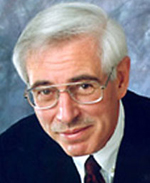Keynote: Thomas O'Rourke
Mon. 10:30-11:15 a.m., Interlocken A/B
 Thomas O'Rourke is a member of the teaching and research staffs at Cornell University and the University of Illinois at Urbana-Champaign. His teaching and professional practice include geotechnical engineering for earth retention systems, foundations, and soil–structure interaction; earthquake engineering; underground construction technology; and engineering of large geographically distributed systems (such as water supplies, gas and liquid fuel systems, electric power, and transportation facilities).
Thomas O'Rourke is a member of the teaching and research staffs at Cornell University and the University of Illinois at Urbana-Champaign. His teaching and professional practice include geotechnical engineering for earth retention systems, foundations, and soil–structure interaction; earthquake engineering; underground construction technology; and engineering of large geographically distributed systems (such as water supplies, gas and liquid fuel systems, electric power, and transportation facilities).
O'Rourke is an elected member of the U.S. National Academy of Engineering and a Fellow of the American Association for the Advancement of Science and has won numerous awards for his engineering work. In 1998, he was elected to the Earthquake Engineering Research Institute Board of Directors and served as President from 2003-2004. He testified before the U.S. House of Representatives Science Committee in 1999 on engineering implications of the 1999 Turkey and Taiwan earthquakes and on the reauthorization of the National Earthquake Hazards Reduction Program in both 2003 and 2009. He has served on numerous earthquake reconnaissance missions and was a member of the U.S. National Academies Committee on New Orleans Regional Hurricane Protection Projects. He is a member of the National Institute of Standards and Technology Advisory Committee for Earthquake Hazards Reduction, which serves as the national advisory committee for NEHRP.
O'Rourke has developed engineering solutions for problems concerning foundation performance, ground movement effects on structures, earth retaining structures, pipelines, earthquake engineering, tunneling, and infrastructure rehabilitation, both on a research and consulting basis. He has investigated and contributed to the mitigation of the effects of extreme events—including natural hazards and human threats—on civil infrastructure systems and has developed techniques for evaluating ground movement patterns and stability for a variety of excavation, tunneling, micro-tunneling, and mining conditions. Additionally, he developed geographical information systems and network analysis procedures for geographically distributed infrastructure systems in areas vulnerable to earthquakes and other natural disasters.
